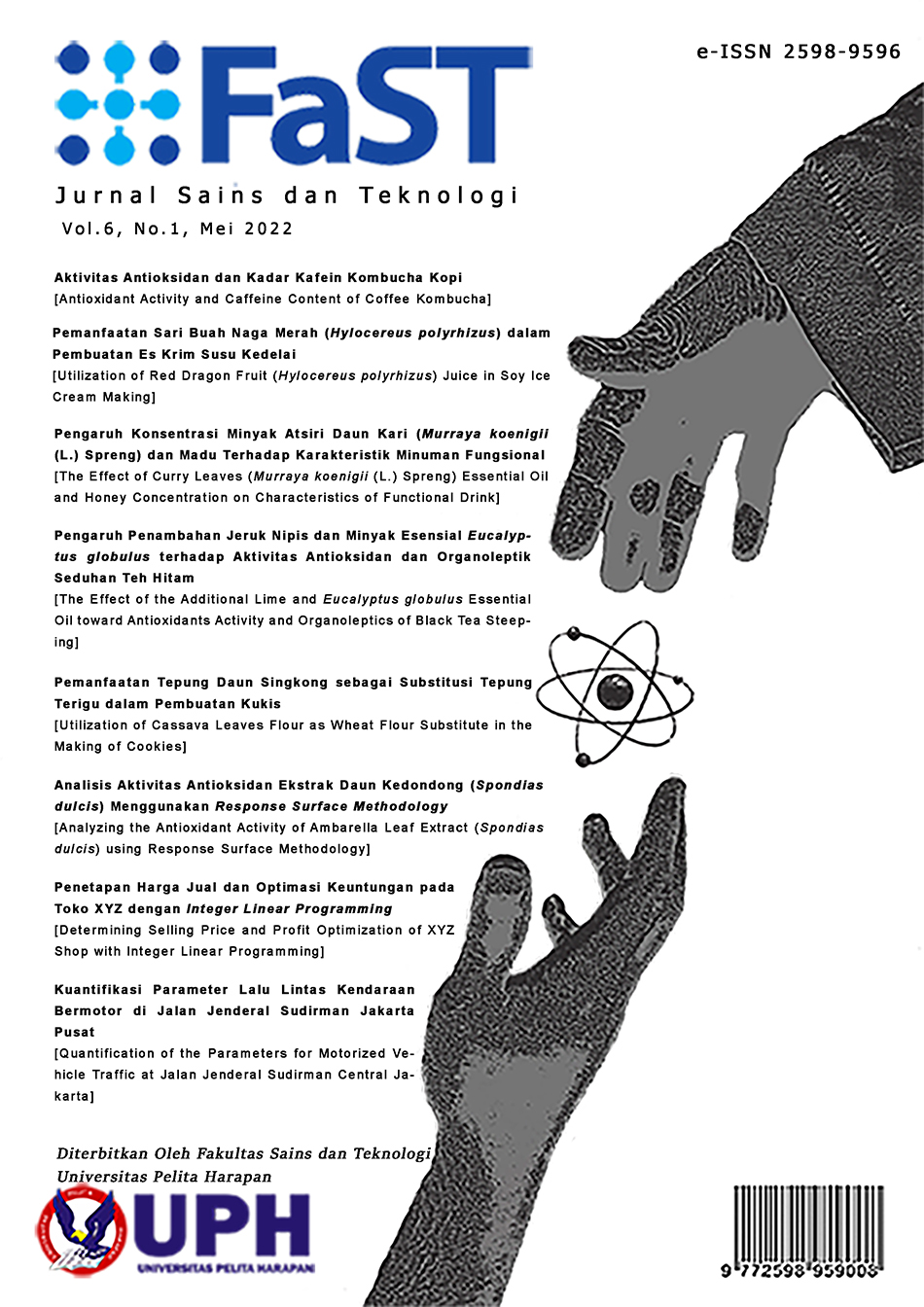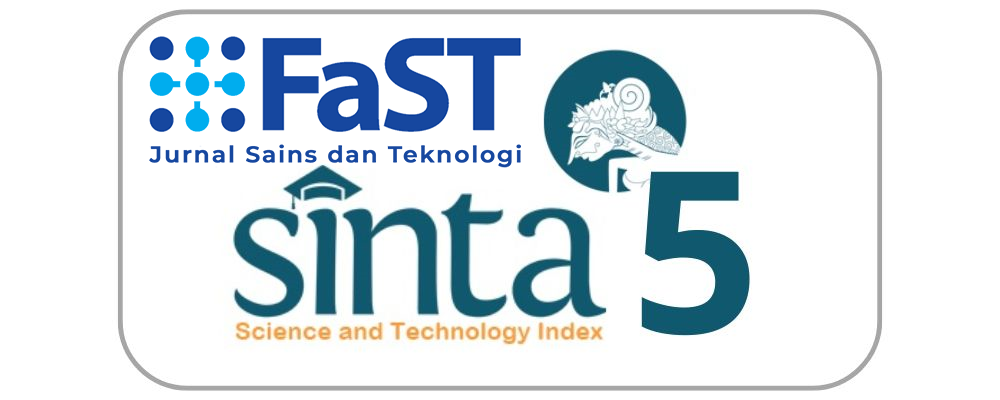Analisis Aktivitas Antioksidan Ekstrak Daun Kedondong (Spondias dulcis) Menggunakan Response Surface Methodology [Analyzing the Antioxidant Activity of Ambarella Leaf Extract (Spondias dulcis) using Response Surface Methodology]
DOI:
https://doi.org/10.19166/jstfast.v6i1.5314Keywords:
Spondias dulcis, antioksidan, DPPH, Response Surface Methodology, MinitabAbstract
Antioxidants are substances that mitigate the impacts of free radicals on the body, in which they can be extracted from plants. One common Indonesian plant that has a potential to be used as a source of antioxidants is the ambarella plant (Spondias dulcis). The aim of this research is to measure the antioxidant activity of ambarella leaf’s extract via response surface methodology to determine the optimum conditions required to facilitate maximum extraction. Ambarella leaves were dried and soaked in methanol by using various combinations of time, methanol concentration and solid:solvent ratio (SSR). Antioxidant activity was measured using the DPPH test. The Response Surface Methodology (RSM) was utilized to determine the optimum conditions. The obtained optimum conditions were 26.5 hours, 82.2% methanol and a solid:solvent ratio of 1:14.6.
Bahasa Indonesia Abstract:
Antioksidan adalah sejenis senyawa yang dapat meminimalkan pengaruh radikal bebas dalam tubuh, dimana senyawa tersebut dapat diekstraksi dari tanaman. Salah satu tanaman di Indonesia yang memiliki potensi digunakan sebagai sumber antioksidan adalah kedondong (Spondias dulcis). Tujuan penelitian ini adalah untuk mengukur aktivitas antioksidan ekstrak daun kedondong, serta menemukan kondisi yang optimum untuk ekstraksi daun kedondong dengan menggunakan response surface methodology. Daun kedondong dikeringkan lalu dimaserasi menggunakan berbagai kombinasi parameter waktu, konsentrasi pelarut metanol, dan solid:solvent ratio (SSR). Aktivitas antioksidan ekstrak lalu diukur menggunakan uji DPPH. Response Surface Methodology (RSM) digunakan untuk menemukan kondisi yang optimum. Kondisi maserasi yang optimum adalah 26,5 jam, konsentrasi pelarut metanol 82,2% dan SSR 1:14,6.
References
Aydar, A. Y. (2018). Utilization of Response Surface Methodology in Optimization of Extraction of Plant Materials. Statistical Approaches with Emphasis on Design of Experiments Applied to Chemical Processes. https://doi.org/10.5772/intechopen.73690
Che Sulaiman, I., Basri, M., Masoumi, H., Chee, W., Ashari, S., & Ismail, M. (2017). Effects of temperature, time, and solvent ratio on the extraction of phenolic compounds and the anti-radical activity of Clinacanthus nutans Lindau leaves by response surface methodology. Chemistry Central Journal, 11, 54. https://doi.org/10.1186/s13065-017-0285-1
Chew, K., Ng, S., Thoo, Y., Khoo, M., Wan Aida, W., & Ho, C. (2011). Effect of ethanol concentration, extraction time and extraction temperature on the recovery of phenolic compounds and antioxidant capacity of Centella asiatica extracts. International Food Research Journal, 18, 571-578.
Crimmins, E. (2015). Lifespan and Healthspan: The Past, Present, Promise. The Gerontologist, 55(6), 901-911. https://doi.org/10.1093/geront/gnv130
Domingo, C., De Vera, W., Pambid, R., & Austria, V. (2019). Playing with the Senses: Application of Box-Behnken Design to Optimize the Bukayo Formulation. Food Research, 3(6), 833-839. https://doi.org/10.26656/fr.2017.3(6).190
Islam, S. M. A., Ahmed, K. T., Manik, M. K., Wahid, M. A., & Kamal, C. S. I. (2013). A comparative study of the antioxidant, antimicrobial, cytotoxic and thrombolytic potential of the fruits and leaves of Spondias dulcis. Asian Pacific Journal of Tropical Biomedicine, 3(9), 682-691. https://doi.org/10.1016/s2221-1691(13)60139-2
Morton, J. (1987). Ambarella. Retrieved January 23, 2021 from https://hort.purdue.edu/newcrop/morton/ambarella_ars.html
Seo, J., Lee, S., Elam, M., Johnson, S., Kang, J., & Arjmandi, B. (2014). Study to find the best extraction solvent for use with guava leaves (Psidium guajava L.) for high antioxidant efficacy. Food Science & Nutrition, 2(2), 174-180. https://doi.org/10.1002/fsn3.91
Tummala, S., Kuppusamy, G., Kumar, M., Krishnamurthy, P., Yamjala, K., Tripuraneni, N., & Prakash, A. (2015). Formulation and optimization of oxaliplatin immuno-nanoparticles using Box-Behnken design and cytotoxicity assessment for synergistic and receptor-mediated targeting in the treatment of colorectal cancer. Artificial Cells, Nanomedicine, and Biotechnology, 44(8). https://doi.org/10.3109/21691401.2015.1111226
Wong, B., Tan, C., & Ho, C. (2013). Effect of solid-to-solvent ratio on phenolic content and antioxidant capacities of “Dukung Anak” (Phyllanthus niruri). International Food Research Journal, 20(1), 325-330.
Wu, L., Yick, K., Ng, Z., & Yip, J. (2011). Shape characterization for optimisation of bra cup moulding. Journal of Fiber Bioengineering and Informatics, 4(3), 235-243. https://doi.org/10.3993/jfbi09201103
Xu, D., Li, Y., Meng, X., Zhou, T., Zhou, Y., Zheng, J., Zhang, J., & Li, H. (2017). Natural antioxidants in foods and medicinal plants: extraction, assessment, and resources. International Journal of Molecular Sciences, 18(1), 96. https://doi.org/10.3390/ijms18010096
Downloads
Published
Issue
Section
License
“Authors who publish with this journal agree to the following terms:
1) Authors retain copyright and grant the journal right of first publication with the work simultaneously licensed under a Creative Commons Attribution License (CC-BY-SA 4.0) that allows others to share the work with an acknowledgement of the work's authorship and initial publication in this journal.
2) Authors are able to enter into separate, additional contractual arrangements for the non-exclusive distribution of the journal's published version of the work (e.g., post it to an institutional repository or publish it in a book), with an acknowledgement of its initial publication in this journal.
3) Authors are permitted and encouraged to post their work online (e.g., in institutional repositories or on their website). The final published PDF should be used and bibliographic details that credit the publication in this journal should be included.”



